Asian Insights
A summary of “Asian Insights” weekly update is published here. The full version is available through paid subscription. Please click here to register your interest. Our executive will get in touch with you.

Ukraine impact on Asia, one month into the war
On reasonable assumptions about the trajectory of the Ukraine conflict, we continue to expect a fair degree of resilience in Asian economies.
- The Ukraine war will affect Asia through two principal channels – slower European growth and higher energy prices. Our analysis suggests that the impact on Asian growth will be lower growth of between 10 and 30 basis points.
- The easing of pandemic restrictions is unfolding as we had expected. This will boost domestic demand and tourism, both of which will have powerful positive impacts on growth. The electronics cycle is holding up better than expected and should support Asian manufactured exports as well.
Taking stock of commodity prices
- We summarise the supply and demand factors in Table 1 and calculate the breakdown of the commodity output as a share of GDP and exports.
|
Baseline Outlook: Winners and Losers from Rising Commodity Prices |
||
|
Indonesia |
Bullish: Coal, CPO, Nickel, Copper |
5.3% of GDP |
|
Balanced: Coffee, Rubber |
0.7% of GDP |
|
|
Malaysia |
Bullish: CPO |
7.0% of GDP |
|
Balanced: Rubber |
0.3% of GDP |
|
|
Thailand |
Bullish: Rice |
0.7% of GDP |
|
Balanced: Rubber |
1.1% of GDP |
|
|
Vietnam |
Bullish: Rice |
0.9% of GDP |
|
Balanced: Coffee, Rubber |
1.7% of GDP |
|
|
The Philippines |
Bullish: Copper, Nickel |
0.6% of GDP |
|
India |
Bullish: Rice |
0.3% of GDP |
Singapore: Policy responses to go beyond S$NEER steepening
- We expect the Monetary Authority of Singapore to announce a one-off upward re-centering of the S$NEER midpoint alongside a 50-100 basis point steepening of the S$NEER slope in its monetary policy statement expected soon given the likelihood of very strong growth.
- Global tech demand remains very robust, while domestic capital spending is also set to revive, adding fuel to the foreign investment-led upturn currently underway. Travel-related, entertainment and recreational activities are also poised for a firmer recovery, as the government relaxes COVID-19 restrictions more substantially.
- In addition to the monetary policy move, also expect more macro-prudential measures to address signs of overheating in the real estate market. It is also likely that the government will hasten the return of foreign workers who have been unable to return to their jobs in Singapore because of border controls – so as to limit the surge in wage costs.

China: Major policy U-turn underway
Vice-premier Liu He convened a rare policy meeting to signal a major policy “U-turn” that paves the way for more concerted pro-growth policies to be introduced soon.
- The recalibration of policy reflects behind-the-scenes pushback on the broad direction of economic policy undertaken by President Xi since the start of 2021. The economic costs of the campaigns to restrict lending to property firms and curb the “disorderly expansion” of capital, and of the government’s zero-COVID stance etc., are being reconsidered.
- While January-February activity indicators beat expectations by a significant margin, the “true” growth rate is probably lower than indicated by official statistics. A host of alternative measures of activity we track point to sluggish demand and weak sentiment.
- What this means for China going forward – higher policy risks in the medium-term as policy and/or regulatory excesses over the past year are unwound in the coming months – with the possibility of a renewed crackdown once the economy is on surer footing.
Asian currencies: Capital flows to offset other drags
The onset of monetary normalization in developed economies and rising geopolitical risk premia leads us to re-examine the trajectories of the region’s currencies.
- Normalising current account balances in 2022 will exert a drag on Asian currencies save for the PHP, IDR and SGD, but positive real yield differentials would cushion the adjustment to varying degrees – the greatest offset seen across INR, IDR and PHP..
- The likelihood of robust FDI inflows into Indian and perhaps Indonesian assets could limit depreciation pressures on both currencies. Robust FDI flows could help the MYR outperform.
- We expect relative underperformance in the INR and the IDR, and view the KRW, TWD, and SGD as likely outperformers.
Highlights from the CAA Weekly Table:
Asian political risks:
- Underlying trends in Malaysia suggest that an early general election which now seems likely will do little to improve long term stability.
Asian economic prospects:
- Indian inflation accelerated but there is little sign that the central bank will respond firmly.
- Indonesia’s robust export growth reflects how well it is doing from rising commodity prices.
- The Philippines’ outlook is improving, given the easing of pandemic-related restrictions.
